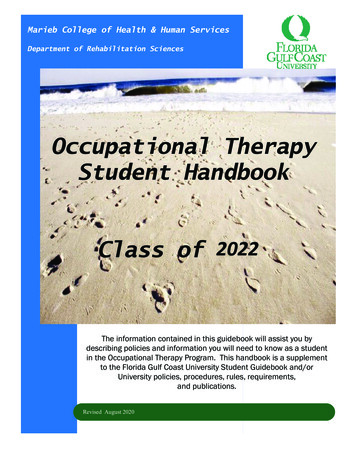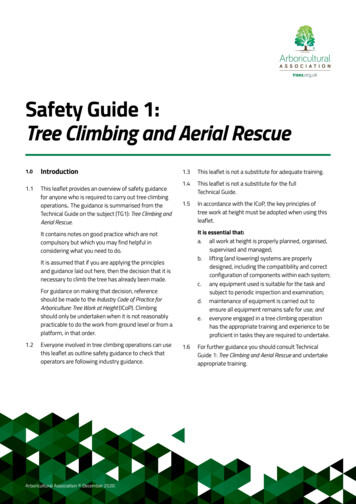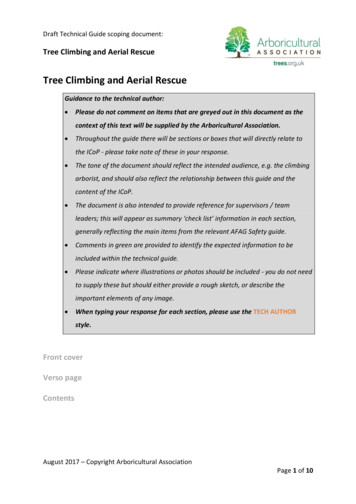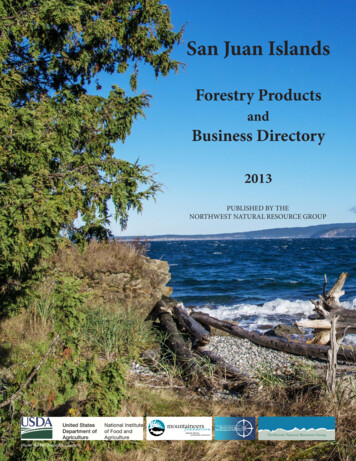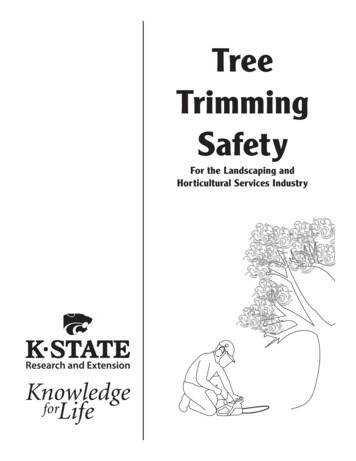
Transcription
TreeTrimmingSafetyFor the Landscaping andHorticultural Services Industry
TreeTrimmingSafetyContentsIntroductionWhat’s Inside? . 3Lesson 1Take Control of Your Own Safety . 4Lesson 2Avoid Shock & Electrocution . 10Lesson 3Preventing Falls from Trees . 14Lesson 4Avoid Being Struck by Trees or Limbs . 18Lesson 5Environmental Hazards . 26Conclusion . 33Quiz Yourself Solutions . 36Written by:Sara Lind, Information specialistMitch Ricketts, Coordinator, Health, Safety and EnvironmentalQuality, K-State Research and ExtensionDisclaimerThis material was produced under grant number 46G3-HT04 andrevised and updated under grant number SH-19503-09-60-F-20from the Occupational Safety and Health Administration, U.S. Department of Labor. It does not necessarily reflect the views or policiesof the U.S. Department of Labor, nor does mention of trade names,commercial products, or organizations imply endorsement by theU.S. government.This booklet was produced by K-State Research and Extension, Kansas State University, Manhattan, Kansas.The information in this publication has been compiled from a variety of sources believed to be reliable and to represent the best currentopinion on the subject. However, neither K-State Research and Extension nor its authors guarantee accuracy or completeness of any information contained in this publication, and neither K-State Researchand Extension or its authors shall be responsible for any errors, omissions, or damages arising out of the use of this information. Additionalsafety measures may be required under particular circumstances.2 – Tree Trimming Safety
What’s Inside?This booklet teaches important safety practices to be followed whenmanually trimming trees.Safety tips, along with real accident reports, have been combined tohelp you protect yourself from the hazards involved in this type ofwork.Use this booklet in conjunction with hands-on safety training andequipment operator’s manuals.Tree Trimming Safety – 3
Lesson 1Objectives1. Name the most common types oftree trimming accidents.2. Interpret the meaning of commonwarning signs and labels.3. Identify appropriate protectiveequipment.4. Indicate hazards to be assessedbefore beginning operation.Take Control ofYour Own SafetyGreatest DangersThe most common types of serious tree trimming accidents are:1. ElectrocutionYou can be seriously injured or killed if you come into contactwith an electric line.Accident ReportEmployee Electrocuted When Branch Falls on LineSummary OSHA Accident Inspection 1099688358An employee was trimming a tree that was near an overheadpower line. The employee misjudged the distance, cut the branch,and it fell on the line. The employee, who was still holding ontothe branch, was electrocuted.Always keep a safe distance from power lines.Refer to page 12 for more information.2. Falling From TreesYou can be seriously injured or killed if you fall from a tree.Accident ReportEmployee Falls After Disconnecting Both LanyardsSummary of OSHA Accident Inspection 126621820While working in a tree, an employee disconnected one lanyardto move around some limbs. After climbing approximately 60feet up the tree, he disconnected the second lanyard beforereconnecting the first. The employee fell and died of head injuries.Always make sure all safety lines are connected.3. Being Struck by Trees or LimbsYou can be seriously injured or killed if you are struck by fallingtrees or limbs.Accident ReportEmployee Struck by Falling LimbSummary of OSHA Accident Inspection 125616698An employee was felling trees in a forested area when a limb fellfrom an adjacent tree and struck him on the head. The employeewas killed.Always wear a hard hat and do a pre-start inspectionbefore beginning work.4 – Tree Trimming Safety
Help YourselfSafe work habits are important. Here are three important actionsyou can take to be safe on the job site.1. Learn All You Can.To prevent tree trimming accidents, read and follow directionsthat come with all climbing and trimming equipment. Whilereading, pay attention to safety instructions and look for warning labels on the equipment. If you have questions, stop and askyour supervisor before you continue.2. Concentrate on Working Safely.Sometimes you may be tempted to take risky shortcuts. Remember that an accident can leave you permanently injuredor cut your life short. For your safety and the safety of thosearound you, do not take unnecessary risks. No deadline is sopressing you can’t take the time to do your work safely.3. Additional PrecautionsDo not operate machinery or climb trees if you are tired or havetaken drugs or alcohol. If you are on medication, discuss withyour doctor or pharmacist if you are capable of climbing andoperating machinery safely.Choose SafetyTree Trimming Safety – 5
Safety Messages and SignsManufacturers put important safety messages on each piece of equipment and in the operator’s manual. It is critical to read, understandand follow all safety messages.The triangle shape is the symbol for caution. The exclamationmark in the center means Pay Attention. In some instances,the triangle-shaped sign will show a picture. Other times, wordsexplain why the sign is used.Many safety messages use the words Caution, Warning and Danger toget your attention. Following are safety messages and their meanings.Each of these signs will have a written message, and perhaps apicture, about a possibly unsafe condition.CAUTION means you need to be careful. Follow the directions onthe sign or you could get hurt.CAUTION!HEARINGPROTECTIONREQUIREDWARNING is more serious and means you need to follow thedirections on the sign or you could be badly hurt or killed.!WARNINGYOU CAN BECOMECAUGHT IN THEEQUIPMENT’SMOVING PARTS.DANGER is the most serious safety message. If you don’t follow thedirections, you will be seriously injured or killed.!DANGERELECTRIC SHOCKCAN SERIOUSLYINJURE OR KILL YOU.Images displayed in the caution, warning and danger boxes have been recreated from images taken with permission from ASAE S441.3, FEB1999 (R2005),Safety Signs.6 – Tree Trimming Safety
Protective EquipmentCertain equipment is necessary to protect you while trimming trees.The following protective equipment is required.Hard HatA hard hat should be worn to protect your head from fallinglimbs.GlovesGloves may be worn to protect your hands from puncturewounds and cuts.Sturdy, Non-Slip BootsWear boots to keep a firm footing on the ground and reduce therisk of slipping and falling.Climbing EquipmentSafety harnesses, belts, ropes, lanyards, slings and carabiners appropriate to the job are used to keep you secured in the tree.When Operating a Chain saw You Must Wear:Leg ProtectionLeg protection must be worn when performing ground operations. The material should be cut-resistant and cover the entirethigh to the top of each boot.When to Wear Hearing ProtectionOSHA Standard 1910.95 (i) (l) requires hearingprotection to be worn when sound levelsexceed certain limits (generally, a daily averageof 85 or 90 decibels, depending on thecircumstances). These levels can be measuredwith a dosimeter. A hearing conservationprogram requiring hearing tests and otherprecautions may also be necessary. Check withthe equipment operator’s manual, as well asyour supervisor, for suggestions on hearingprotection for each piece of equipment andinstructions on how to wear it properly.Hearing Protection Rules of ThumbHearing protection may be needed if:4 You have to raise your voice significantly tobe heard by someone three feet away.4 After leaving a noisy area, your ears feelplugged or you hear a mild ringing orwhooshing noise that goes away after anhour or two.4 When you start your car in the morning, theradio is so loud from the evening before thatyou have to turn it down.Goggles or Safety GlassesGoggles or safety glasses must be worn at all times to protectyour eyes from foreign objects.Face ShieldA face shield should be worn to protect your face from the kickback of the machine and debris.Hearing ProtectionOver time, you will lose your hearing if you are exposed to loudnoises without protection.Two common types of hearing protection are muffs and plugs.Ear muffs should seal around your ears to properly muffle loudnoises. Wash reusable ear plugs with warm, soapy water aftereach use in order to prevent infection. Discard disposable earplugs after each use.Tree Trimming Safety – 7
Pre-Start ChecklistTreeo Trunk free of cracks, splits or cankers.o No nests, hives or other signs of animal life.o No signs of poison ivy or oak.Equipmento B elts and harnesses free of cracks, cuts andbroken stitching.o Clips, buckles and rivets not loose orbroken.o Ropes and lanyards are dry and showno signs of fraying, intense wear or sundamage.o Snap catches and carabiners close securelyand are the appropriate size for the D-ringsin use.o Other personal protective equipmentused as needed, such as hearing and eyeprotection.Locationo W arning signs and rumble strips are beingused, when necessary, if the site is near aroadway.o Cones and flaggers are used to divert traffic,when necessary.Should you find any hazardswhile climbing, descend the treeimmediately following the inspection,and take appropriate actionto solve the problem.8 – Tree Trimming SafetyPre-Start InspectionA hazard briefing must be performed before the start of each job.During this briefing, you and your supervisor should analyze thepotential dangers of performing the job. Based on the analysis,choose a plan of attack and proper equipment that will help youcarry out the job safely.TreeEnsure the trunk is stable by looking for cracks, splits andcankers. Look for any dead and rotten branches. Watch for anynests, hives, or other signs that animals may be in the tree. Lookfor poison ivy or oak growing on or around the tree.Accident ReportEmployee Suffers InfectionSummary of OSHA Accident Inspection 119705770An employee was trimming trees when his arm came in contactwith poison oak. He suffered an allergic reaction and infection setin his arm before transferring to his leg. He was hospitalized fortreatment.Be on the lookout for poison ivy and oakduring your prestart hazard inspection.EquipmentCheck belts and harnesses for any cracks, cuts or broken stitching. Ensure that all clips, buckles and rivets are not loose or broken. Check ropes and lanyards for signs of fraying and intensewear. Do not use a rope that is wet, has been driven over or hasbeen stored in the sun. These factors will weaken the elasticityand strength of the rope. Check snap catches and carabiners tomake sure they will close securely and are the appropriate size forthe D-ring on your harness or belt.LocationIf working near roadways, use warning signs and rumble strips,when necessary, to alert motorists that employees are in the area.Use cones and flaggers (wearing highly-reflective vests) to diverttraffic away from the area where work is being performed.
Quiz YourselfAnswers can be found on page 36.Select the correct answer for the following sentences from thelist below.a. Dangerb. Cut-resistantc. Alcohold. Trianglee. Electrocution1. Do not operate machinery if you are under the influence ofdrugs or .2. , falls from trees and being struck by trees orlimbs are the three most commonly reported causes of serioustree trimming accidents.3. The shape is the symbol for caution.4. Leg protection consisting of material is requiredwhen operating a chain saw during ground operations.5. is the most serious safety message.Tree Trimming Safety – 9
Lesson 2Objectives1. Differentiate between qualifiedand unqualified line-clearancetree trimmers.2. Recognize electrical hazards.3. Identify minimum distancerequirements.Avoid Shock andElectrocutionQualified vs. UnqualifiedOnly qualified line-clearance tree trimmers are allowed within10 feet of energized power lines. According to OSHA, qualifiedemployees are “those who are knowledgeable in the construction andoperation of electric power generation, transmission, or distributionequipment involved, along with the associated hazards.” To becomea qualified line-clearance tree trimmer, you will need additionaltraining that is beyond the scope of this book.Qualified and unqualified employees are required to keep theminimum distances found in the tables in the next section.Electrical HazardsYou must use extreme caution when working around electrical lines.Electrocution can occur by direct contact, indirect contact or electrical arcing.Electric shock or electrocution will occur when:h You physically touch the line with any part of your body orclothing. Example:4 You touch a power line with your body.Accident ReportEmployee Leans Backward Into Power LineSummary of OSHA Accident Inspection 119596658While descending a tree, an employee leaned back into a powerline. He remained in contact with the 7.2-kilovoltpower line for about 30 seconds before being thrown free. His supervisor performed CPR until emergency medical services arrived.The employee died of electrocution.Always keep a safe distance from power lines.Refer to page 12 for more information.If using an insulated boom or bucket truck,check the operator’s manual to determineit’s maximum effective voltage.Do not exceed this limit.10 – Tree Trimming Safety
Electric shock or electrocution will occur when:h Your body, clothing or equipment touch any material that is incontact with a power line. Example:4 The equipment you are holding touches a power line.Accident ReportEmployee Shocked When Saw Touches LineSummary of OSHA Accident Inspection 123168965An employee was trimming trees from the bucket of an aerial lift.The employee received an electric shock when his saw contacteda 13.2-kilovolt overhead power line.Remember to keep all equipment outsidethe distances found on page 12.Accident ReportEmployee ElectrocutedSummary of OSHA Accident Inspection 123561540A tree trimmer was cutting a branch when a gust of wind blewthe branch into contact with a 35-kilovolt power line. The trimmer, who was touching the branch and tree was electrocuted.Be cautious of sudden wind changes.Electric shock or electrocution will occur when:h The ground around a downed power line becomes electrified.This means you can be electrocuted even when you do notactually touch the power line. Examples:4 You are standing near a downed power line.Accident ReportEmployee Electrocuted by Electrified GroundSummary of OSHA Accident Inspection 301183893A crew was cutting down a tree when it fell into a power line,breaking it. The line arced and bounced around. An employee ranin front of the truck and was electrocuted because the groundwas electrified. His coworkers dragged him from the area, calledfor help, and performed CPR. The employee died 45 minutes afterthe accident.You can be electrocuted if the ground around youbecomes electrified.Electric shock or electrocution will occur when:h Electricity jumps (arcs) from a power line to an object that isnearby. This means you can be electrocuted even when you donot actually touch the power line. Example:4 You use a pole pruner near a power line and electricity arcsfrom the line to the pruner.Tree Trimming Safety – 11
Minimum Approach DistancesAlways assume that electrical lines are energized and work beyondthe following minimum distances to avoid contact. When you mustwork closer than the minimum distances, contact the power company to have the lines de-energized or shielded.Minimum approach distances not only apply to employees, but alsoto all equipment, including ladders and aerial devices.Minimum Approach Distances for Unqualified EmployeesNominal VoltagekV Phase to Phase0.0 to 1.01.1 to 15.015.1 to 36.036.1 to 50.050.1 to 72.572.6 to 121.0138.0 to 145.0161.0 to 169.0230.0 to 242.0345.0 to 362.0500.0 to 550.0785.0 to 3.764.004.244.976.178.0510.551Exceeds phase to ground.Chart taken from ANSI Z133.1-2000. Used with permission.Minimum approach distances for qualified employees can be foundin ANSI Z133.1-2006.12 – Tree Trimming Safety
Quiz YourselfAnswers can be found on page 37.Select the correct answer for the following sentences from the listbelow.a. Arcb. Qualifiedc. Minimumd. Equipment1. You must follow the approach distances unless powerlines have been de-energized or shielded.2. Electricity can ; meaning you can be electrocuted evenwhen you are near, but not touching the power line.3. Additional training, that is beyond the scope of this book, isrequired to become a line clearance tree trimmer.4. Minimum approach distances also apply to .Choose One:I am a line-clearance tree trimmer.a. unqualifiedb. qualifiedTree Trimming Safety – 13
Lesson 3Objectives1. Recognize precautions to preventfalling from trees.2. Identify climbing knots.Preventing Fallsfrom TreesAvoid Injury from Falling4 Always climb trees using ropes or harnesses and use additionalanchor points whenever possible. Do not free-climb.4 Never anchor or tie yourself to the limb you are cutting on.4 Always tie ladders into the tree.4 Do not cut your safety lines. Keep all ropes and harnesses awayfrom chain saws and other cutting equipment.4 Use extra caution when working on slopes.4 Use an aerial device to trim trees that are not safe to climb.4 Remove cut limbs from the tree so that you don’t accidentallyuse them for support when you descend.4 Do not climb when the tree is wet, icy or snow-covered or whenthe weather is extremely windy.4 Never turn your back on a tree being felled.4 When working above concrete or a paved surface, watch outfor branches that might bounce back and strike you or yourequipment.YESNOPosition yourself on limbs, closeto the trunk, that can supportyour weight.Never stand on a limb that isnot strong enoughto fully support you.Accident ReportEmployee Falls From LadderSummary of OSHA Accident Inspection 200450096An employee who was trimming trees put a ladder in the bed ofa pickup to use it as a height extender. There were no support attachments on the ladder and the base section did not have securefooting. The employee fell off the ladder, approximately 14 feet,broke his neck and died.Never use a ladder in a pickup bed for added height.14 – Tree Trimming Safety
KnotsBelow are some knots commonly used for climbing. For a morecomplete list of knots and explanations on how and when to usethem refer to:Arborists Certification Study Guide, International Societyof Aboriculture. www.isa-arbor.comTree Climber’s Guide, International Society of Aboriculture.www.isa-arbor.comNational Tree Climbing Guide, United States Departmentof Agriculture’s National Tree Climbing Program.www.fs.fed.us/treeclimbing/Figure Eight KnotThe figure eight knot can be used for a variety of purposes.Examples include but are not limited to:4a stopper knot at the end of hitches and rappel lines4to tie two pieces of rope together4to attach lanyardsFollow the steps below to tie a figure eight knot.Prusik KnotThe Prusik is a friction knot. This means the knot can slide easilywithout tension. Examples include but are not limited to:4attach climbing equipment to rappel lines4create adjustable lanyards4use as an ascending knotFollow the steps below to tie a Prusik knot.Blake’s HitchThe Blake’s hitch is a modified version of the Prusik knot. It is also afriction knot. After making the hitch, the end should always be tiedwith a figure eight stopper knot.Follow the steps below to tie a Blake’s hitch.Tree Trimming Safety – 15
Clove HitchThe clove hitch is a knot that can be used to tie equipment to theend of the rope or to the tree. The clove hitch should never be usedas a lifeline.Follow the steps below to tie a clove hitch.Bowline KnotThe bowline knot is formed at the end of a rope and does not slip ortighten under stress. Examples include but are not limited to:4tie a climbing line to a carabiner4attach a throw bag to its lineFollow the steps below to tie a Bowline knot.16 – Tree Trimming Safety
Quiz YourselfAnswers can be found on page 38.Select the correct answer for the following sentences from the listbelow.a. Anchorb. Bowlinec. Aerial deviced. Stoppere. Lifelinef. Prusik1. A Blake’s hitch should always include a figure eightknot.2. Use an to trim trees that are too dangerous toclimb.3. Never yourself into the limb you are working on.4. A clove hitch should never be used as a .5.knot6.knotTree Trimming Safety – 17
Lesson 4Objectives1. Recognize ways to avoid beingstruck by trees and limbs.2. Develop safe chain saw operatingprocedures.3. Identify tree felling danger zones.4. Compare different fellingtechniques.Avoid Being Struckby Trees or LimbsPrevent Injury from Trees and Limbs4 Limbs that cannot be dropped safely should be lowered with arope.4 Do not leave cut branches in a tree. Drop or lower them safely tothe ground.4 Do not turn your back on a tree where branches are being cut ora tree is being felled.4 Follow a two-tree rule when felling. No one (other than thefeller) should be within two tree lengths of the tree being felled.4 Maintain a greater distance when trimming or felling on a slopewhere logs could roll or slide.4 Always be aware of your surroundings. Talk with coworkers toensure you know what kind of work they are doing and where.Accident ReportFalling Tree Strikes Employee on HeadSummary of OSHA Accident Inspection 111100657An employee turned his back to a tree that was being trimmed. Alimb struck the employee on the back of the head and killed him.Never turn your back to a tree being trimmed.Accident ReportLimb Rebounds; Saw Strikes EmployeeOSHA Accident Inspection 125907865An employee was using a chain saw to cut a 3 inch diameterbranch. After he had made the final cut, the branch fell andbounced after hitting a concrete walk. The cut limb struck theemployee in the face and the chain saw struck his right arm. Hesuffered deep cuts as well as nerve and tendon damage.Slowly lower limbs with a rope when workingabove a hard surface.18 – Tree Trimming Safety
Using a Chain sawGeneral Instructions:4 Read the chain saw's operator’s manual before attempting tooperate equipment.4 Always be alert. Chain saw work is strenuous and fatiguing.4 When carrying a chain saw, always turn the engine off.4 Do not refuel the chain saw with the engine running. Shut itoff and wait at least 5 minutes for it to cool down. Wipe up anyspills immediately.4 Never smoke while refueling.4 Never work alone. Make sure someone is close by for help incase of an emergency.4 Keep hands and feet away from the wood that is being cut.4 Ensure your chain is sharp. Dull chains are hard to use.4 Make sure the chain tension is correct. Refer to the operator’smanual for instruction. If the chain is too loose, it could comeoff during operation and if it is too tight, it could damage thesaw.4 Never operate the saw above your chest. Reaching above yourchest makes the saw hard to control.Accident ReportEmployee Cut by Chain sawSummary of OSHA Accident Inspection 120134390An employee was standing on a slope cutting a log into pieces.He slipped on the damp ground and hit his upper left arm withthe chain saw. The arm was severely cut and the employee washospitalized.Always stand on a solid, flat, dry surfacewhen operating a chain saw.YESNOStart a chain sawon the ground.Never start a chain sawagainst your body.Tree Trimming Safety – 19
Kickback is a common cause of injury associated with chain saws.Kickback occurs when the chain around the end of the bar contactsa hard object (such as a knothole) or when the teeth of the saw arepinched in the wood. This kicks the saw backward and upward, rapidly, where it can strike you.To reduce kickback:4 Do not cut with the upper section of the bar. Insert the saw fully.4 When cutting, always stand at an angle, with a firm balance onthe ground or branch, so that if the saw kicks back, it will avoidyour neck and head.4 Make sure your saw has an anti-kickback device. Chain sawsmanufactured after 1995 have one or more devices alreadyinstalled on the machine. For saws older than 1995, a retrofit kitmay be available.Accident ReportEmployee Killed When Chain saw Kicks BackSummary of OSHA Accident Inspection 120169669An employee was trimming trees and cutting downed limbs. Thetip of his chain saw struck a limb and kicked back, striking himacross the neck. He died due to a severe cut to his throat.Always insert the blade fully to reduce kickback.20 – Tree Trimming SafetyYESNOInsert the blade fullyto reduce kickback.Do not cut with thetip of the blade.
Trimming BranchesTo safely trim branches, use three cuts to remove the branchcompletely.Cut #2Cut #1Cut #3Cut #1Felling TechniquesWhen a tree must be removed, there are several things to considerbefore cutting.1. Ensure coworkers and all others maintain a two-tree length distance. If the tree is going to fall downhill, increase the distancedepending on the slope.2. Look for any fences, buildings or power lines and avoid fellingtoward them.3. Work only in good weather. Never work in strong winds, lightning, rain or any time when visibility is low.Inspect the Tree4 Is the tree leaning in one direction? This will play a major rolein the direction the tree will fall.4 Check the trunk (where the cuts are going to be made) for knotholes, cracks or signs of rot that could hinder the felling operation.4 Ensure the tree has no interlocking branches or vines fromanother tree. If it does, they must be separated prior to felling.Also, survey the crown of the tree for any material that maybreak loose as the tree falls.4 Trim any low branches that are in your way.Tree Trimming Safety – 21
Locate the Escape AreasEscapeAreaDangerTreeDanger ZoneBefore you begin to cut, you must determine your escape area. Thisis the area you will go to immediately after the back cut has beenmade and the tree is beginning to fall.To locate the escape areas, you must first determine the dangerzones. Two danger zones can be identified and must be avoided toprevent serious injury or death. The first danger zone is located in asemi-circle, from half the diameter of the tree toward the directionof the fall. The second danger zone is one-quarter of the diameter ofthe tree and located in the opposite direction of the intended fall.Fellers MUST avoid these two danger zones.ZoneEscapeAreaDirection of FallThe escape areas are then located between the danger zones. Alwaysretreat to one of these areas as the tree is beginning to fall.Accident ReportEmployee Struck by Falling TreeSummary of OSHA Accident Inspection 114147440An employee was working on the ground, cutting down a tree.When the tree fell, it struck him on the head, killing him.Move to one of the two escape areas after making theback cut.Back CutHinge WoodMake the CutTop CutScarfBottom CutDirection of Fall22 – Tree Trimming SafetyThere are three key parts to a successful felling.1. Scarf. The scarf is a notch that is cut out of the tree by makinga top and bottom cut. There are three commonly used notchesthat can make a good scarf and we will discuss them later in thischapter. The scarf is important because it controls the directionof the fall.2. Hinge wood. The hinge wood is a piece of the tree, equal to 1 10of the tree’s diameter, that is left uncut. It serves as a hinge, afterthe final cut has been made, to push the tree in the intendeddirection of fall.3. Backcut. The backcut is the final cut and helps clear the woodup to the hinge wood so the tree can easily fall.
Types of NotchesCommon Cutting MistakeNote: The notches can be made at any height on the tree, but always start high enough to allow room to complete all three cuts.Conventional NotchTop Cut: Cut downward at a 45 angle to a point that is ¼ to 1 3 thetree’s diameter.Bottom Cut: Cut straight across the tree until you reach the endpoint of the top cut.Back Cut: Start the cut 1 inch above the notched corner on theopposite side of the tree. Cut straight across, until you reach thehinge wood.Back cut is too high.Creates poor hinge.Conventional NotchFor more information on loggingoperations visit www.osha.govBack CutHinge WoodTop Cut45 AngleBottom CutDirection of FallTree Trimming Safety – 23
Common Cutting MistakesBottom cut is not steepenough to form a 45 angle.Open-Face NotchTop Cut: Cut downward at a 70 angle to a point that is ¼ to 1 3 thetree’s diameter.Bottom Cut: Cut upward at a 20 angle until you reach the endpoint of the top cut.Back Cut: On the opposite side of the tree, cut straight across,at the same height of the notched corner, until you reach thehinge wood.Open-Face NotchEndpoints do not meet.Dutchman’s notch.Back CutHinge WoodTop Cut90 AngleBottom CutDirection of FallHumboldt NotchTop Cut: Cut straight across to a point that is ¼ to 1 3 of the tree’sdiameter.Bottom Cut: Cut upward at a 45 angle until you reach the endpoint of the top cut.Back Cut: Start out 1 inch above the notched corner on the opposite side of the tree. Cut straight across until you reach thehinge wood.Back CutHinge WoodHumboldt Notch45 AngleTop CutBottom CutDirection of Fall24 – Tree Trimming Safety
Quiz YourselfSelect the correct answer for the following sentences from the listbelow. Answers can be found on page 39.a. Backb. Offc. Aboved. Grounde. Branchesf. Hinge woodg. Open-face1. Never operate a chain saw your chest.2. is a piece of wood equal to 1 10 the tree’sdiameter that is left uncut.3. When carrying a chain saw, always turn the engine .4. Alw
Mitch Ricketts, Coordinator, Health, Safety and Environmental . Quality, K-State Research and Extension. Disclaimer. This material was produced under grant number 46G3-HT04 and revised and updated under grant number SH-19503-09-60-F-20 . from the Occupational Safety and Health Administration, U.S. De-partment of Labor.




